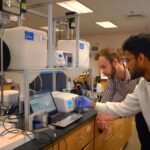
Where many see waste, UMBC’s Lee Blaney, assistant professor of chemical, biochemical and environmental engineering, sees opportunity.
As Blaney explains in Chemical & Engineering News, poultry litter is a very abundant waste product that is regularly used as a fertilizer, but its high phosphorus content poses challenges. Blaney and the students in his lab extract phosphorus from poultry litter in a way that provides a sustainable source of that nutrient for farmers who want to use it, and leaves behind rich organic matter that can be used as fertilizer by farmers who do not want to add more phosphorus to their soil.
In Maryland, new regulations will be fully implemented by 2022 that will limit the amount of phosphorus allowable in fields, to prevent phosphorus runoff that can damage local watersheds. The amount of phosphorus already in the soil will impact the amount of phosphorus farmers can add to their land as fertilizer.
Blaney uses reactors to extract phosphorus from poultry litter. The extracted phosphorus can be sold to farmers who want to add higher levels of the nutrient to their land within the new guidelines, and the leftover material can be used by people who want fertilizer for their land but have already hit the phosphorus limit.
“The easiest thing to do—and what has been historically successful—is to use litter as fertilizer,” says Blaney. He explains that the method that he uses in his lab can be a cost-effective option for farmers to add phosphorus to their land within legal limits, reuse a material that is abundant, keep costs low, and access a new source of revenue in excess isolated phosphorus that can be resold. Blaney is working with several farmers on Maryland’s Eastern Shore, and hopes to have a phosphorus extraction system up and running on one farm in Wicomico County, Maryland in the next year.
Read “How to get the good stuff out of chicken manure” in Chemical & Environmental News.
Image: Lee Blaney works with a student in his lab. Photo by Tim Ford, coordinator of illustrative services in the biological sciences department at UMBC.





